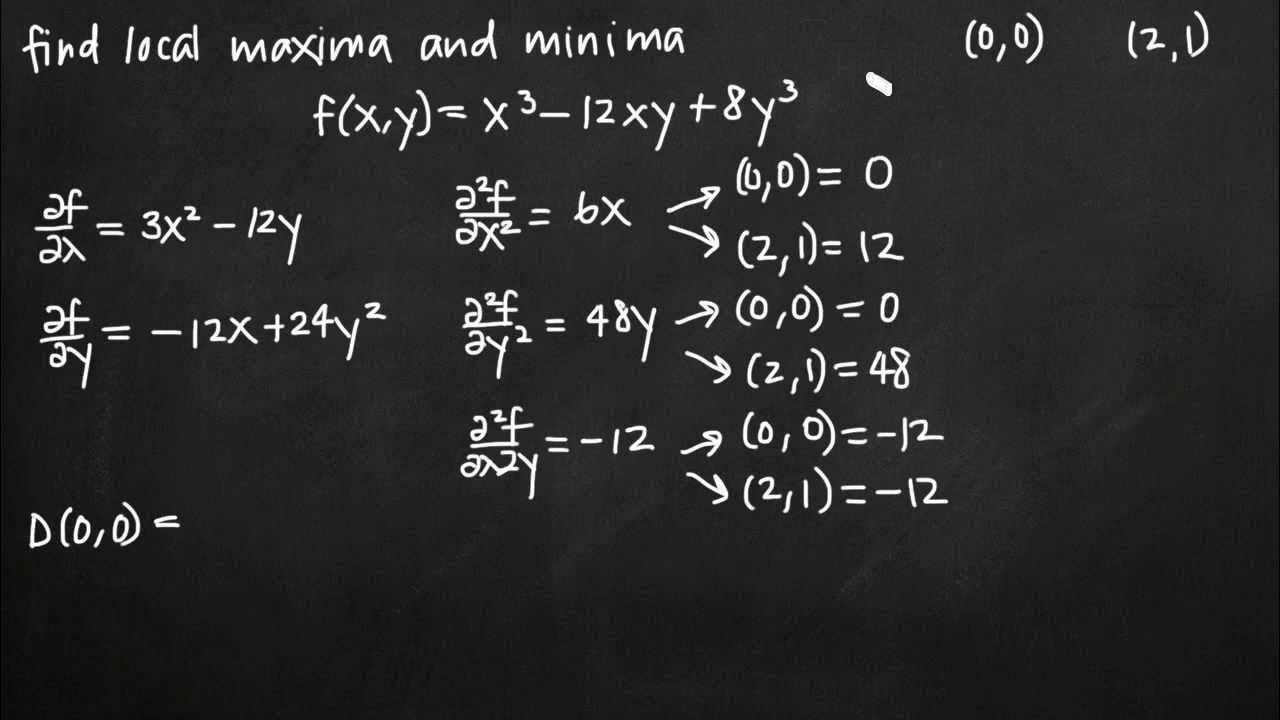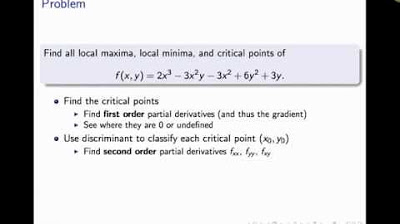Local Extrema, Critical Points, & Saddle Points of Multivariable Functions - Calculus 3
TLDRThe video script offers a comprehensive guide on identifying critical points, saddle points, and local extrema in multivariable functions. It outlines a step-by-step process starting with finding points of interest where the first partial derivatives with respect to x and y equal zero. The script then explains calculating 'd' using second partial derivatives and the mixed partial derivative. 'd' helps determine if a point is a local minimum, maximum, or saddle point. The video provides two examples, calculating derivatives and evaluating 'd' to classify each point. The first example identifies a local minimum at (2,2) with a value of 30. The second example reveals a saddle point at the origin, and two local minima at (1,1) and (-1,-1), each with a value of 8. This script is an excellent resource for understanding multivariable calculus concepts.
Takeaways
- 📌 To identify critical points or saddle points in a multivariable function, set the first partial derivatives with respect to x and y to zero.
- 🔍 After identifying a point of interest, calculate the determinant 'd' using the formula d = (f_xx * f_yy) - (f_xy)^2, where f_xx, f_yy, and f_xy are the second partial derivatives.
- ➡️ If d is positive and f_xx is also positive, the point represents a local minimum.
- ⬆️ If d is positive but f_xx is negative, the point is a local maximum.
- 🔁 If d is negative, the point is a saddle point, meaning it is neither a local minimum nor a local maximum.
- 🧮 To evaluate a point, substitute the x and y values into the function to determine if it is a local minimum, maximum, or saddle point.
- 📐 For the function f(x, y) = 10 - 3x^2 - 2y^2 + 8y + 12x, the critical point at (2, 2) is a local minimum with a value of 30.
- 🔢 For the function f(x, y) = 2x^4 + 2y^4 - 8xy + 12, the points (0, 0), (1, 1), and (-1, -1) are points of interest.
- 🔄 The point (0, 0) for the second function is a saddle point, as d is negative at this location.
- 🏁 The points (1, 1) and (-1, -1) for the second function are local minima, each with a value of 8.
- ✅ The process involves finding partial derivatives, evaluating determinants, and substituting values to classify points as local minima, maxima, or saddle points.
Q & A
What are the steps to identify critical points in a multivariable function?
-First, find points where the first partial derivatives with respect to x and y are both zero. Then, calculate the determinant d, which is f_xx * f_yy - (f_xy)^2, where f_xx, f_yy, and f_xy are the second partial derivatives. Analyze d to determine the nature of the point: if d > 0 and f_xx > 0, it's a local minimum; if d > 0 and f_xx < 0, it's a local maximum; if d < 0, it's a saddle point.
How can you determine if a point is a saddle point?
-A point is a saddle point if the determinant d is negative. Regardless of the values of the second partial derivatives, a negative d indicates the point is not a local minimum or maximum but a saddle point.
What does it mean if the determinant d is positive and f_xx is also positive?
-If the determinant d is positive and the second partial derivative with respect to x (f_xx) is also positive, it indicates that the function has a local minimum at that point.
What does it mean if the determinant d is positive but f_xx is negative?
-If the determinant d is positive and the second partial derivative with respect to x (f_xx) is negative, it indicates that the function has a local maximum at that point.
What is the role of the mixed partial derivative (f_xy) in determining the nature of a critical point?
-The mixed partial derivative (f_xy) is used to calculate the determinant d. Its value contributes to the overall sign of d, which is crucial in determining whether a point is a local minimum, local maximum, or a saddle point.
How do you find the first partial derivatives of a function with respect to x and y?
-To find the first partial derivatives, differentiate the function with respect to x while treating y as a constant to get the partial derivative with respect to x (f_x). Similarly, differentiate the function with respect to y while treating x as a constant to get the partial derivative with respect to y (f_y).
What is the process to evaluate the function at a critical point?
-To evaluate the function at a critical point, substitute the x and y coordinates of the critical point into the original function to find the function's value at that point.
How do you identify local extrema in a multivariable function?
-Local extrema are identified by finding critical points where the first partial derivatives are zero and then using the determinant d and the signs of the second partial derivatives to determine if the point is a local minimum, local maximum, or neither.
What is the significance of the second partial derivatives in analyzing critical points?
-The second partial derivatives are used to calculate the determinant d, which is essential for classifying a critical point as a local minimum, local maximum, or saddle point.
How does the value of the function at a critical point relate to its classification as a local minimum or maximum?
-The value of the function at a critical point, combined with the sign of the determinant d and the second partial derivative f_xx, helps determine if the point is a local minimum or maximum. A lower function value at a point with d > 0 and f_xx > 0 indicates a local minimum, while a higher function value with d > 0 and f_xx < 0 indicates a local maximum.
Can a point be both a local minimum and a local maximum?
-No, a point cannot be both a local minimum and a local maximum. A point is either a local minimum, a local maximum, or a saddle point, as determined by the signs of the determinant d and the second partial derivatives.
What happens if the determinant d is zero?
-If the determinant d is zero, the second derivative test is inconclusive, and additional methods such as the use of the gradient or higher-order derivatives may be required to classify the critical point.
Outlines
📚 Identifying Critical Points and Local Extremes in Multivariable Functions
This paragraph introduces the topic of identifying critical points, saddle points, and local extreme values in functions of multiple variables, such as f(x, y). The steps involve finding points where the first partial derivatives with respect to x and y are zero, calculating the determinant d using second partial derivatives, and determining the nature of the point based on the sign of d and the second partial derivative with respect to x. The function f(a, b) is evaluated to ascertain if it's a local minimum or maximum, or a saddle point. The process is illustrated with a specific function, f(x, y) = 10 - 3x^2 - 2y^2 + 8y + 12x, and the critical points are identified as x=2 and y=2.
🔍 Analyzing the Function's Behavior at Specific Points
The second paragraph delves into analyzing the function's behavior at the identified critical points. It explains how to calculate the determinant d using the second partial derivatives and the mixed partial derivative. The sign of d and the second partial derivative with respect to x are used to classify the point as a local minimum, local maximum, or saddle point. The example continues with the function f(x, y) = 2x^4 + 2y^4 - 8xy + 12, where the partial derivatives are found and set to zero to identify points of interest. The second partial derivatives are calculated, and the determinant d is evaluated at each point to determine the nature of the critical points.
🔢 Evaluating the Function at Critical Points to Determine Local Minima and Saddles
The final paragraph focuses on evaluating the function at the critical points to determine if they are local minima or saddle points. It continues the example with the function f(x, y) = 2x^4 + 2y^4 - 8xy + 12, calculating the determinant d at the points (0,0), (1,1), and (-1,-1). The evaluation reveals that (0,0) is a saddle point, while both (1,1) and (-1,-1) are local minima with the same value of 8. The paragraph concludes with a summary of the findings: a saddle point at the origin, and two local minima at the points (1,1) and (-1,-1).
Mindmap
Keywords
💡Critical Points
💡Saddle Points
💡Local Extreme Values
💡First Partial Derivatives
💡Second Partial Derivatives
💡Hessian Matrix
💡Mixed Partial Derivative
💡Local Minimum
💡Local Maximum
💡Function Evaluation
💡Gradient
Highlights
Identify critical points and saddle points in a multivariable function by setting first partial derivatives with respect to x and y equal to zero.
Calculate the determinant d using second partial derivatives and the mixed partial derivative squared.
If d is positive and f_xx is positive, the point is a local minimum.
If d is positive and f_xx is negative, the point is a local maximum.
If d is negative, the point is a saddle point, not a local min or max.
Given function f(x, y) = 10 - 3x^2 - 2y^2 + 8y + 12x, find critical points by setting f_x = 0 and f_y = 0.
The point of interest is (2, 2) for the given function.
Calculate second partial derivatives f_xx = -6, f_yy = -4, and mixed partial f_xy = 0.
d = f_xx * f_yy - f_xy^2 = 24, indicating the point (2, 2) is not a saddle point.
Since d > 0 and f_xx < 0, the point (2, 2) is a local minimum with value 30.
For the function f(x, y) = 2x^4 + 2y^4 - 8xy + 12, find critical points by solving x^3 - y = 0 and y^3 - x = 0.
Points of interest are (0, 0), (1, 1), and (-1, -1).
At (0, 0), d is negative, indicating a saddle point.
At (1, 1), d > 0, f_xx > 0, so it's a local minimum with value 8.
At (-1, -1), d > 0, f_xx > 0, another local minimum with value 8.
The origin (0, 0) is a saddle point.
There are two local minima at (1, 1) and (-1, -1), each with value 8.
Transcripts
Browse More Related Video

Use the Second Derivative Test to Find Any Extrema and Saddle Points: f(x,y) = -4x^2 + 8y^2 - 3

Local extrema and saddle points of a multivariable function (KristaKingMath)

Second partial derivative test intuition

Find and classify critical points

Second partial derivative test

Critical Points of Functions of Two Variables
5.0 / 5 (0 votes)
Thanks for rating: